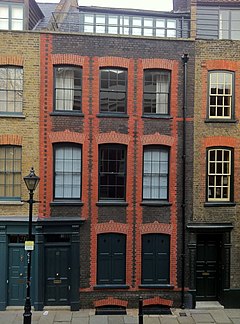Fournier Street
| Fournier Street, London | |
|---|---|
 Classic Georgian Townhouse of 1726 |
|
| Fournier Street, London shown within Greater London | |
| London borough | |
| Ceremonial county | Greater London |
| Region | |
| Country | England |
| Sovereign state | United Kingdom |
| Post town | LONDON |
| Postcode district | E1 6QE |
| Dialling code | 020 |
| Police | Metropolitan |
| Fire | London |
| Ambulance | London |
| EU Parliament | London |
| UK Parliament | |
| London Assembly | |
Fournier Street, formerly Church Street, is an 'east-end' street of 18th-century houses in Spitalfields, in the London Borough of Tower Hamlets. It runs between Commercial Street and Brick Lane. It is named after a man of Huguenot extraction, George Fournier.
Fournier Street was the last to be built on the Wood-Michell estate in Spitalfields, London. It was developed in response to the settlement of a significant community of wealthy French Huguenots around Spitalfields, many of whom brought silk-weaving skills from Nantes, Lyons and other cities. Thus, although initially intended as domestic dwellings, many were immediately occupied by the silk industry. The houses mainly date from the 1720s and together they form one of the most important and best preserved collections of early Georgian domestic town-houses in Britain.
Fournier Street was designed to be both well appointed and of a higher standard than previous residential developments in the local area and consequently the houses were purchased and leased by the 'master' silk-weavers and silk mercers. These buildings are notable for their fine wooden panelling and elaborate joinery such as carved staircases, fireplaces and highly detailed door-cases which were constructed by the craftsmen of the day. Silk-weaving activities occupied the uppermost floors to gain the best light for the looms – hence the development of the unusual highly glazed lofts in these houses. The ground floor rooms commonly served as elaborate showrooms for the finished products.
One of the finest examples is Howard House, No. 14 Fournier Street, a mansion house, built circa 1726 by 'carpenter and gentleman', William Taylor, for his own occupation but subsequently leased by silk weavers, 'Signeratt and Bourdillon'. It has three floors and a large garrett attic which once contained the loom. It is here that the silk for Queen Victoria's Coronation gown was woven. The unique hardwood staircase balustrade is carved to display fluted columns with Ionic capitals placed on each turn for one hundred steps. Indeed, each step is expertly carved with a masterly design of hops, barley, and wild roses.
No. 23 Fournier Street (pictured) is perhaps the best surviving example of a classic, single-fronted early Georgian town house of simple but elegant design. This house retains the original, typical arrangement of cellar-basement, three brick storeys and a mansard garrett with a weather boarded front and wide weaver's windows.
...
Wikipedia

